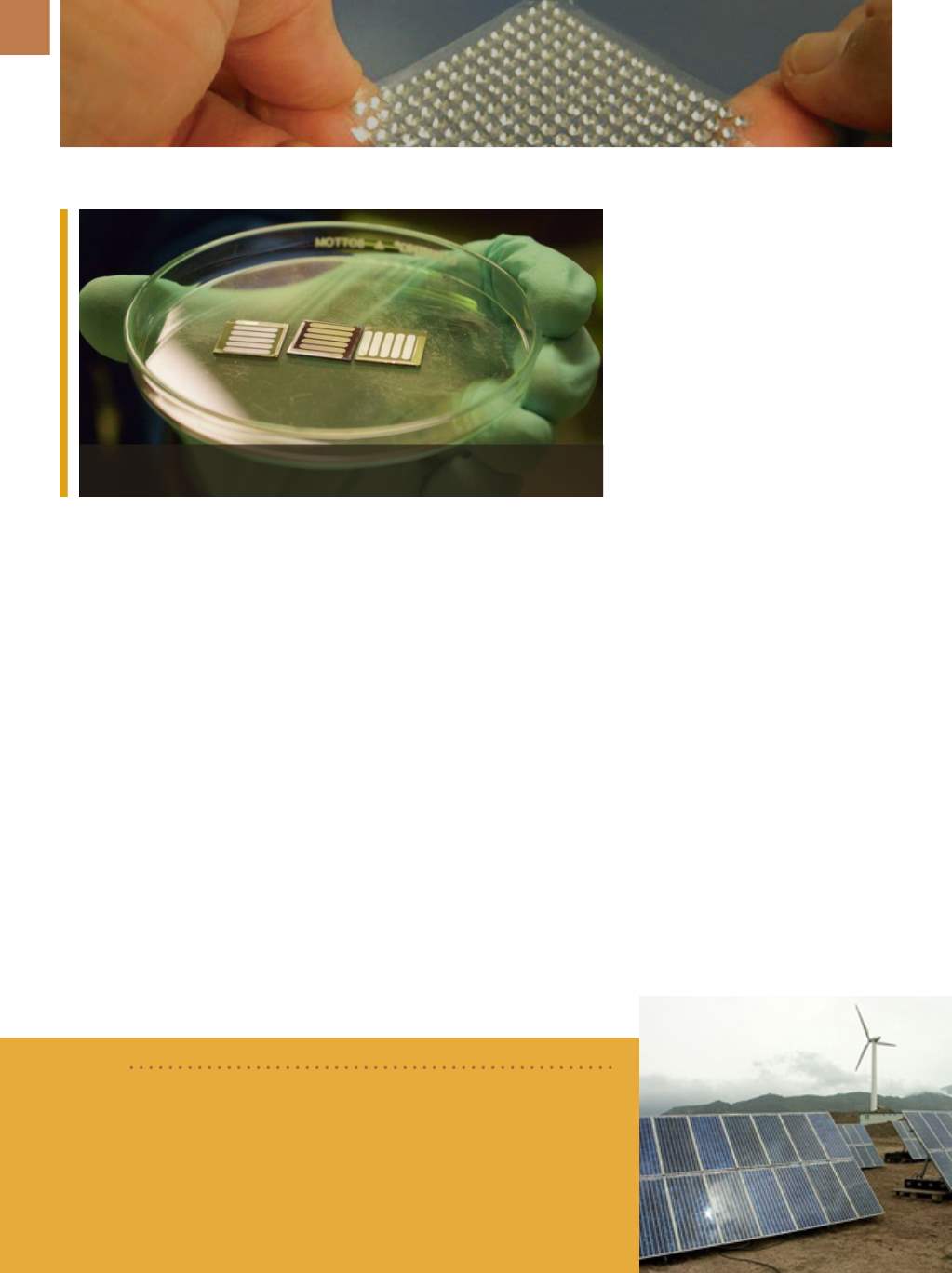

A D V A N C E D M A T E R I A L S & P R O C E S S E S | N O V E M B E R / D E C E M B E R 2 0 1 5
1 4
NEW TECHNIQUE STABILIZES
PEROVSKITE SOLAR CELLS
University of California, Los Ange-
les Professor Yang Yang and his team re-
port they have conquered the primary
obstacle of perovskite by protecting it
between two layers of metal oxide—a
significant advance toward stabilizing
perovskite solar cells. Their new cell
construction extends the cell’s effective
life in air by more than 10 times, with
only a marginal loss of efficiency in con-
verting sunlight to electricity.
Yang says there are several fac-
tors that lead to quick deterioration in
normally layered perovskite solar cells.
The most significant is that the widely
used top organic buffer layer has poor
stability and cannot effectively protect
the perovskite layer from moisture in
the air, speeding cell degradation. The
buffer layers are important to cell con-
struction because electricity generated
by the cell is extracted through them.
The team replaced those organ-
ic layers with metal oxide layers that
sandwich the perovskite layer, protect-
ing it from moisture. The difference is
dramatic. The metal oxide cells lasted
60 days in open-air storage at room
temperature, retaining 90% of their
original solar conversion efficiency.
The next step is to make the metal
oxide layers more condensed for better
efficiency and to seal the solar cell for
even longer life with no loss of efficien-
cy. Yang expects that this process can
be scaled up to production now that
the main perovskite problem has been
solved.
For more information: Yang
Yang, 310.825.4052,
yangy@ucla.edu,
yylab.seas.ucla.edu.
NANOPARTICLES IMPROVE
ULTRATHIN CIGSe SOLAR
CELLS
Helmholtz-Zentrum Berlin, Germa-
ny, researchers are inquiring how to use
Perovskite solar cells with metal oxide hole and electron transport layers.
Courtesy of Tunde Akinloye/CNSI.
BRIEF
Researchers from the
University of Kashan,
Iran, produced nanostructures
in bar form and studied their performance in dye-sensitized solar cells. Core-
shell structures made of zinc oxide and titanium oxide were grown on indium
tin oxide beds in nanobar form. Results show that the nanostructures have
high transparency in the visible light range and have lower electrical resistance
compared to common samples. The high transparency enables adsorption of
larger wavelengths in the visible light range—an important step in increasing
efficiency.
www.kashanu.ac.ir/english.ENERGY TRENDS
nanoparticle arrangements to improve
solar cells and other opto-electronic de-
vices. CIGSe solar cells have proven high
efficiencies and are established thin
film devices with active layers of a few
micrometers thickness. But, because in-
dium is a rare element, the active layer
should be as thin as possible, reducing
efficiency, as less light is absorbed. “It
took me more than a year to be able
to produce ultrathin layers of only
0.46
μ
m or 460 nm, which still reach rea-
sonable efficiencies up to 11.1%,” says
Ph.D. student Guanchao Yin.
Colleagues in Amsterdam pro-
duced an array of SiO
2
nanoparticles
directly on the molybdenum substrate,
which corresponds to the back contact
of the solar cell. On top of this struc-
tured substrate, Yin grew an ultrathin
CIGSe layer, followed by all other layers
and contacts needed for the solar cell.
With this configuration, efficiency in-
creased from 11.1% to 12.3%, and the
short circuit current density of the ultra-
thin CIGSe cells increased by more than
2 mA/cm
2
. With additional antireflective
nanoparticles at the front, efficiencies
grew to 13.1%.
Further studies indicate that the
nanoarray of dielectric SiO
2
nanoparti-
cles at the back side could also increase
efficiencyby reducing chances for charge
carrier recombination.
For more infor-
mation: Guanchao Yin, 030.8062.43721,
guanchao.yin@helmholtz-berlin.de,
www.helmholtz-berlin.de.


















